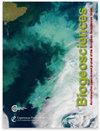Modeling coupled nitrification–denitrification in soil with an organic hotspot
IF 3.9
2区 地球科学
Q1 ECOLOGY
引用次数: 0
Abstract
Abstract. The emission of nitrous oxide (N2O) from agricultural soils to the atmosphere is a significant contributor to anthropogenic greenhouse gas emissions. The recycling of organic nitrogen (N) in manure and crop residues may result in spatiotemporal variability in N2O production and soil efflux which is difficult to capture by process-based models. We propose a multi-species, reactive transport model to provide detailed insight into the spatiotemporal variability in nitrogen (N) transformations around such N2O hotspots, which consists of kinetic reactions of soil respiration, nitrification, nitrifier denitrification, and denitrification represented by a system of coupled partial differential equations. The model was tested with results from an incubation experiment at two different soil moisture levels (−30 and −100 hPa) and was shown to reproduce the recorded N2O and dinitrogen (N2) emissions and the dynamics of important carbon (C) and N components in soil reasonably well. The simulation indicated that the four different microbial populations developed in closely connected but separate layers, with denitrifying bacteria growing within the manure-dominated zone and nitrifying bacteria in the well-aerated soil outside the manure zone and with time also within the manure layer. The modeled N2O production within the manure zone was greatly enhanced by the combined effect of oxygen deficit, abundant carbon source, and supply of nitrogenous substrates. In the wetter soil treatment with a water potential of −30 hPa, the diffusive flux of nitrate (NO3-) across the manure–soil interface was the main source of NO3- for denitrification in the manure zone, while at a soil water potential of −100 hPa, diffusion became less dominant and overtaken by the co-occurrence of nitrification and denitrification in the manure zone. Scenarios were analyzed where the diffusive transport of dissolved organic carbon or different mineral N species was switched off, and they showed that the simultaneous diffusion of NO3-, ammonium (NH4+), and nitrite (NO2-) was crucial to simulate the dynamics of N transformations and N2O emissions in the model. Without considering solute diffusion in process-based N2O models, the rapid turnover of C and N associated with organic hotspots can not be accounted for, and it may result in the underestimation of N2O emissions from soil after manure application. The model and its parameters allow for new detailed insights into the interactions between transport and microbial transformations associated with N2O emissions in heterogeneous soil environments.基于有机热点的土壤硝化-反硝化耦合模拟
摘要农业土壤向大气排放一氧化二氮(N2O)是人为温室气体排放的重要来源。有机肥和作物残茬中有机氮(N)的再循环可能导致N2O生产和土壤外排的时空变化,这是基于过程的模型难以捕捉的。我们提出了一个多物种反应输运模型,以详细了解N2O热点周围氮(N)转化的时空变异性,该模型由土壤呼吸、硝化、硝化反硝化和反硝化的动力学反应组成,由耦合偏微分方程系统表示。在两种不同土壤湿度水平(- 30 hPa和- 100 hPa)下对该模型进行了孵化实验,结果表明,该模型可以较好地再现记录的N2O和二氮(N2)排放以及土壤中重要碳(C)和N组分的动态。模拟结果表明,4种不同的微生物种群在紧密联系而又独立的层中发育,反硝化细菌生长在粪便区内,硝化细菌生长在粪便区外通气良好的土壤中,随着时间的推移也生长在粪便层内。在缺氧、碳源丰富和含氮基质供应的共同作用下,模拟的粪肥区N2O产量显著提高。在水势为−30 hPa的湿润土壤处理中,硝态氮(NO3-)通过粪土界面的扩散通量是粪区NO3-反硝化的主要来源,而在−100 hPa的土壤水势下,扩散不再占主导地位,而是被粪区硝化和反硝化的共存所取代。分析了溶解有机碳或不同矿物N的扩散输运被关闭的情景,结果表明NO3-、铵态氮(NH4+)和亚硝酸盐(NO2-)的同时扩散对模拟模型中N转化和N2O排放的动态至关重要。在基于过程的N2O模型中,如果不考虑溶质扩散,则无法考虑与有机热点相关的C和N的快速更替,并且可能导致低估施用有机肥后土壤N2O排放量。该模型及其参数允许对非均质土壤环境中与N2O排放相关的运输和微生物转化之间的相互作用提供新的详细见解。
本文章由计算机程序翻译,如有差异,请以英文原文为准。
求助全文
约1分钟内获得全文
求助全文
来源期刊

Biogeosciences
环境科学-地球科学综合
CiteScore
8.60
自引率
8.20%
发文量
258
审稿时长
4.2 months
期刊介绍:
Biogeosciences (BG) is an international scientific journal dedicated to the publication and discussion of research articles, short communications and review papers on all aspects of the interactions between the biological, chemical and physical processes in terrestrial or extraterrestrial life with the geosphere, hydrosphere and atmosphere. The objective of the journal is to cut across the boundaries of established sciences and achieve an interdisciplinary view of these interactions. Experimental, conceptual and modelling approaches are welcome.
 求助内容:
求助内容: 应助结果提醒方式:
应助结果提醒方式:


